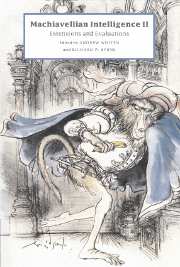Book contents
- Frontmatter
- Contents
- Contributors
- Preface
- 1 Machiavellian intelligence
- 2 Friendships, alliances, reciprocity and repair
- 3 Why Machiavellian intelligence may not be Machiavellian
- 4 Social intelligence and success: Don't be too clever in order to be smart
- 5 Minding the behaviour of deception
- 6 The Machiavellian mindreader
- 7 Exploiting the expertise of others
- 8 Primates' knowledge of their natural habitat: As indicated in foraging
- 9 Evolution of the social brain
- 10 The modulatory of social intelligence
- 11 The Technical Intelligence hypothesis: An additional evolutionary stimulus to intelligence?
- 12 Protean primates: The evolution of adaptive unpredictability in competition and courtship
- 13 Egalitarian behaviour and the evolution of political intelligence
- 14 Social intelligence and language: Another Rubicon
- Index
8 - Primates' knowledge of their natural habitat: As indicated in foraging
Published online by Cambridge University Press: 23 November 2009
- Frontmatter
- Contents
- Contributors
- Preface
- 1 Machiavellian intelligence
- 2 Friendships, alliances, reciprocity and repair
- 3 Why Machiavellian intelligence may not be Machiavellian
- 4 Social intelligence and success: Don't be too clever in order to be smart
- 5 Minding the behaviour of deception
- 6 The Machiavellian mindreader
- 7 Exploiting the expertise of others
- 8 Primates' knowledge of their natural habitat: As indicated in foraging
- 9 Evolution of the social brain
- 10 The modulatory of social intelligence
- 11 The Technical Intelligence hypothesis: An additional evolutionary stimulus to intelligence?
- 12 Protean primates: The evolution of adaptive unpredictability in competition and courtship
- 13 Egalitarian behaviour and the evolution of political intelligence
- 14 Social intelligence and language: Another Rubicon
- Index
Summary
Introduction
Humphrey (1976) suggested that primate information processing skills, as displayed in laboratory learning tasks, exceed the demands of finding food, finding shelter and avoiding danger in the natural habitat, and he hypothesised that the apparent surplus capability evolved in response to the demands posed by life in complex social groups. Other chapters in this book attempt to spell out the empirical predictions of Humphrey's hypothesis, termed the ‘social intelligence’ or ‘Machiavellian intelligence’ hypothesis (Byrne & Whiten, 1988; Cheney & Seyfarth, 1992), and to evaluate the evidence from studies of social behaviour and brain size. In 1976 Humphrey had little information available on how primates find food in their natural habitat, and his statement about the relative simplicity of this task was mainly speculation. An alternative to Humphrey's viewpoint is that primates are capable of learning the relative positions and characteristics of a very large number of objects and topographical features in their natural habitat and that they use this stored information, in combination with current cues, to find food, to discriminate food from non-food objects, and to travel efficiently and safely. In this chapter, the questions of what information primates possess about the structure of their habitat and how such information might contribute to their survival and reproductive success are examined.
To form an evolutionary explanation for as complex a phenomenon as primate learning and memory capabilities requires that the capabilities of interest be well described and that a reasonable guess can be made about their biological value in the animals' evolutionarily relevant environment.
- Type
- Chapter
- Information
- Machiavellian Intelligence IIExtensions and Evaluations, pp. 207 - 239Publisher: Cambridge University PressPrint publication year: 1997
- 22
- Cited by



